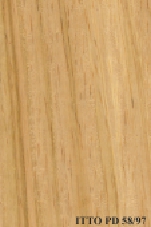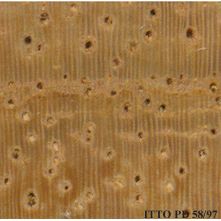
FARO (Daniellia soyauxii)
Trade Name
Faro
Scientific Name
Daniellia soyauxii Rolfe
Family
LEGUMINOSAE
Common Names
Gbessi (Sierra Leone); Oziya (Nigeria); Shedua (Ghana); Faro (Côte d`Ivoire); Ogea (United Kingdom); Daniellia (Germany); Bolengu (Zaire); Lonlaviol (Gabon); N'su (Equatorial Guinea); Sinfa N'dola (Congo); Faro
Scientific Name Synonyms
Cyanothyrsus soyauxii Harms
Description Of The Tree
Botanical Description
The tree reaches a height of 43 m, with trunk diameters from 100 to 150 cm. The bole is remarkably straight and cylindrical, clear for about 20 m in length, generally unbuttressed or with very low ridges.
Natural Habitat
Daniellia soyauxii occurs in dense rain forests, and in mixed forests, in small groups or as a fairly large population.
Wood Identification
Anatomic Description Of Wood
Wood diffuse porous. Occasionally vessels exclusively solitary (over 90%). Tangential diameter of vessel lumina 200 micras or more (large). Vestured pits. Vessels per mm2 less than 6 (rare). Simple perforation plates. Vessel-ray pits similar to intervessel pits Axial parenchyma in marginal or in seemingly marginal bands. Paratracheal axial parenchyma scanty and/or vasicentric. Axial parenchyma lozenge-aliform. Axial parenchyma storied. Prismatic crystals in chambered axial parenchyma cells and/or in fibers. 3 to 4 ce 4 to 10 rays per mm (medium). Rays storied. Rays 1 to 4 seriate. Occasionally prismatic crystals in the ray cells. Body ray cells procumbent with one row of upright and/or square marginal cells (Kribs-III). Non-septate fibers. Fibers with simple to minutely bordered pits.
-
 Wood Macro Photo Tangential Plane
Wood Macro Photo Tangential Plane
-
 Wood Micro Photo Of Transversal Section
Wood Micro Photo Of Transversal Section
Availability
Cites Status
Unrestricted
General Wood Description
Color
The sapwood is whitish, it has a thickness of 10 to 18 cm. The heartwood is pale pinkish brown to reddish brown with greenish-brown streaks, it is clearly demarcated. The silver figure is fine.
COLOR INDEX (1=Black, 7=Light yellow,white)
6
Grain
Straight or slightly interlocked, sometimes with an influence on further processing operations.
Texture
The texture is mostly medium to coarse.
Luster
This wood is frequently low in luster.
Natural Durability
Not durable; important risks of decay attacks at any processing step, from logs up to final products. It must receive preservative treatment. Sensible to termites attack. Heartwood is sensible to Lyctus attacks.
Natural durability index (1= Very high durability, 7=Vey low durability)
5
Internal Growth Stresses
No growth stresses are reported in this species.
Silica Content
Silica Content: Silica presence is reported. Amounts over 0.05% may affect wood processing. Silica Value: 0.92
Resistance To Impregnation
Moderately easy to treat with a partial penetration of the preservative products.
Wood Physical Properties
Basic Density or Specific Gravity (O.D. weight/vol. green) (g/cm³)
0.52
Air-dry Density (Weight and volume at 12%MC) (g/cm³)
0.57
Total shrinkage Tangential (Saturated to 0%MC) (%)
6.6
Total shrinkage Radial (Saturated to 0%MC) (%)
3.6
Drying Defects
Ease of Drying: Drying is rather slow and sometimes difficult to perform. Drying Defects: Risks of checks. Kiln Schedules: The kiln schedule has been tested.
Recommended Dry Kiln Schedule
FR-5
Dimensional stability ratio (Total Tangential Shrinkage %/Total Radial Shrinkage %)
1.8
Wood Chemical Properties
Wood Mechanical Properties
Bending Strength (MOR),12%MC (kgf/cm²)
645
Stiffness (MOE) 12%MC (kgf/cm²)
119045
Compression parallel to fiber 12%MC (kgf/cm²)
304
Compression perpendicular to fiber 12%MC (kgf/cm²)
32
Shear strength radial 12%MC (kgf/cm²)
60
Janka hardness (side) 12%MC (kgf)
400
Janka hardness (end grain) 12%MC (kgf)
504
Workability
Sawing
It is easy to saw.
Rotary Veneer Cutting
Suitable for peeling if treated.
Sliced Veneer
Suitable for peeling if treated.
Blunting Effect
Slight blunting effect; ordinary tools can be used for sawing and machining.
Machining
Machining of this species is reportedly easy.
Planing
Easy; no particular problems.
Moulding
Easy; no particular problems.
Boring
Easy; no particular problems.
Mortising
Easy; no particular problems.
Nailing
No particular problem.
Gluing
Glues well if basic gluing technical rules are followed.
Sanding
Easy to perform; it gives good results.
Polishing
Needs pre-coating.
Steam Bending
Steam bending is difficult.
Response To Hand Tools
No particular problems.
REFERENCED USES
End Uses Summary
HOUSING GENERAL, boards, frames, steps, panelling, fittings, FURNITURE AND CABINETS, common furniture, PLYWOOD AND VENEER, cores, PACKING, heavy packing, pallets, OTHER AND MUSICAL INSTRUMENTS, door core, coffin
General Housing
- 10 - Silica in Timbers
Boards
- 13 - Dry kiln schedules for commercial woods. Temperate and tropical. Section III. Latin American (Mexico, Central, and South America) Woods–Conventional Temperatures
Frames
- 16 - Woods of the World
Steps
- 17 - Tree Conservation Database
Paneling
- 18 - W3TROPICOS Missouri Botanical Garden
Fittings
- 19 - Silica in Timbers
Furniture Cabinets
- 21 - Tropical timbers of the world. Part III-Southeast Asian and Oceanian Species.
Furniture, Common
- 23 - Handbook of Hardwoods
Panels, Veneers
- 25 - Directory of Timber Trade Malaysia
Cores
- 27 - Embassy of Brazil in Japan
Packing
- 45 - Recopilación y Análisis de Estudios Tecnológicos de Maderas Peruanas
Heavy Packing
- 47 - Arvores Brasileiras
Pallets
- 48 - The strength properties of timbers
Door Cores
- 76 - Descripción General y Anatómica de 105 Maderas del Grupo Andino.
Coffin
- 78 - Amazonian Timbers for the International Market
Please Provide Information To View Producer Information